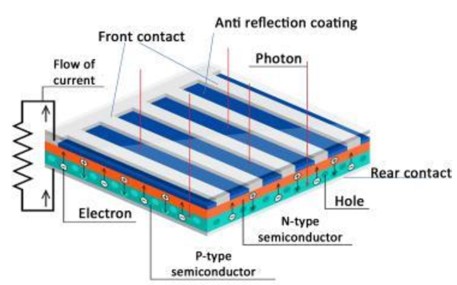- Definition and Types of Energy
- Myths And Misconceptions About Energy
- The Relationship Between Energy and Environment
- Climate Change and Carbon Footprint
- Greenhouse Gas Effect
- The Role of Human-Induced Greenhouse Gases and Energy Consumption
- Energy Efficiency and Sustainability
- Renewable Energy Sources and Future Perspectives (video)
- Play and Learn
- Solar Energy Conversions
- Solar Energy Worldwide
- Solar Energy in Partner Countries
- Positive and Negative Impacts
- Technologies for Harnessing Solar Energy
- Solar thermal energy technologies and applications
- Electricity Generation Methods
- Passive Heating and Cooling of Residences with the Sun
- Concentrator solar power (CSP) systems and electricity generation
- Systems and Applications That Generate Electricity directly from solar rays
- Photovoltaic Cells and Panels
- Domestic PV Systems
- Off-Grid PV Systems
- Hybrid Connected Systems
- Materials Used in PV Cells
- Play and Learn
Materials Used in PV Cells
PV cells are made of special materials to generate electricity. The most commonly used material is crystalline silicon. Crystalline silicon cells are divided into two groups: single crystal silicon and multi-crystal silicon. These materials provide an efficiency between 14% and 19% when converting sunlight into electricity. In addition, materials such as amorphous silicon (a-Si), cadmium telluride (CdTe) and copper indium selenide (CIS) are also used. Amorphous silicon is used in thin film technology and its efficiency is between 4% and 8%. Cadmium telluride is cheaper and more efficient than other thin film cells.

CIS provides the highest efficiency among thin film technologies. New generation PV cells include concentrator PV cells and organic PV cells. In concentrator PV cells, sunlight is collected with lenses or mirrors and made stronger. Organic PV cells are produced from flexible materials such as plastic or polymer. PV cells have two different layers called n-type and p-type for their operation. These layers allow electrical charges to move. When sunlight falls on this cell, an electric current is created inside and thus energy is produced.